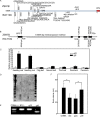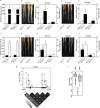Genetic control of the root system in rice under normal and drought stress conditions by genome-wide association study
- PMID: 28686596
- PMCID: PMC5521850
- DOI: 10.1371/journal.pgen.1006889
Genetic control of the root system in rice under normal and drought stress conditions by genome-wide association study
Abstract
A variety of adverse conditions including drought stress severely affect rice production. Root system plays a critical role in drought avoidance, which is one of the major mechanisms of drought resistance. In this study, we adopted genome-wide association study (GWAS) to dissect the genetic basis controlling various root traits by using a natural population consisting of 529 representative rice accessions. A total of 413 suggestive associations, containing 143 significant associations, were identified for 21 root traits, such as maximum root length, root volume, and root dry weight under normal and drought stress conditions at the maturation stage. More than 80 percent of the suggestive loci were located in the region of reported QTLs for root traits, while about 20 percent of suggestive loci were novel loci detected in this study. Besides, 11 reported root-related genes, including DRO1, WOX11, and OsPID, were found to co-locate with the association loci. We further proved that the association results can facilitate the efficient identification of causal genes for root traits by the two case studies of Nal1 and OsJAZ1. These loci and their candidate causal genes provide an important basis for the genetic improvement of root traits and drought resistance.
Conflict of interest statement
The authors have declared that no competing interests exist.
Figures






Similar articles
-
Identification of Markers for Root Traits Related to Drought Tolerance Using Traditional Rice Germplasm.Mol Biotechnol. 2021 Dec;63(12):1280-1292. doi: 10.1007/s12033-021-00380-1. Epub 2021 Aug 16. Mol Biotechnol. 2021. PMID: 34398447
-
Pinpointing genomic regions associated with root system architecture in rice through an integrative meta-analysis approach.Theor Appl Genet. 2022 Jan;135(1):81-106. doi: 10.1007/s00122-021-03953-5. Epub 2021 Oct 8. Theor Appl Genet. 2022. PMID: 34623472
-
Environmental Response and Genomic Regions Correlated with Rice Root Growth and Yield under Drought in the OryzaSNP Panel across Multiple Study Systems.PLoS One. 2015 Apr 24;10(4):e0124127. doi: 10.1371/journal.pone.0124127. eCollection 2015. PLoS One. 2015. PMID: 25909711 Free PMC article.
-
Genetic dissection of drought resistance based on root traits at the bud stage in common bean.Theor Appl Genet. 2021 Apr;134(4):1047-1061. doi: 10.1007/s00122-020-03750-6. Epub 2021 Jan 10. Theor Appl Genet. 2021. PMID: 33426592
-
Proofing Direct-Seeded Rice with Better Root Plasticity and Architecture.Int J Mol Sci. 2021 Jun 4;22(11):6058. doi: 10.3390/ijms22116058. Int J Mol Sci. 2021. PMID: 34199720 Free PMC article. Review.
Cited by
-
Increase Crop Resilience to Heat Stress Using Omic Strategies.Front Plant Sci. 2022 May 17;13:891861. doi: 10.3389/fpls.2022.891861. eCollection 2022. Front Plant Sci. 2022. PMID: 35656008 Free PMC article. Review.
-
The Plastidial DIG5 Protein Affects Lateral Root Development by Regulating Flavonoid Biosynthesis and Auxin Transport in Arabidopsis.Int J Mol Sci. 2022 Sep 13;23(18):10642. doi: 10.3390/ijms231810642. Int J Mol Sci. 2022. PMID: 36142550 Free PMC article.
-
Genome-Wide Association Study on Root System Architecture and Identification of Candidate Genes in Wheat (Triticum aestivum L.).Int J Mol Sci. 2022 Feb 6;23(3):1843. doi: 10.3390/ijms23031843. Int J Mol Sci. 2022. PMID: 35163763 Free PMC article.
-
Loci and natural alleles underlying robust roots and adaptive domestication of upland ecotype rice in aerobic conditions.PLoS Genet. 2018 Aug 10;14(8):e1007521. doi: 10.1371/journal.pgen.1007521. eCollection 2018 Aug. PLoS Genet. 2018. PMID: 30096145 Free PMC article.
-
Multiple genomic regions influence root morphology and seedling growth in cultivated sunflower (Helianthus annuus L.) under well-watered and water-limited conditions.PLoS One. 2018 Sep 20;13(9):e0204279. doi: 10.1371/journal.pone.0204279. eCollection 2018. PLoS One. 2018. PMID: 30235309 Free PMC article.
References
-
- Zhang Q, Wing R. Genome studies and molecular genetics: understanding the functional genome based on the rice model. Curr Opin Plant Biol. 2013. May;16(2):129–32. doi: 10.1016/j.pbi.2013.04.003 - DOI - PubMed
-
- Hu HH, Xiong LZ. Genetic Engineering and Breeding of Drought-Resistant Crops. Annu Rev Plant Biol. 2014;65:715–41. doi: 10.1146/annurev-arplant-050213-040000 - DOI - PubMed
-
- Uga Y, Sugimoto K, Ogawa S, Rane J, Ishitani M, Hara N, et al. Control of root system architecture by DEEPER ROOTING 1 increases rice yield under drought conditions. Nature Genetics. 2013. September;45(9):1097–102. doi: 10.1038/ng.2725 - DOI - PubMed
-
- Champoux MC, Wang G, Sarkarung S, Mackill DJ, O'Toole JC, Huang N, et al. Locating genes associated with root morphology and drought avoidance in rice via linkage to molecular markers. Theor Appl Genet. 1995. June;90(7–8):969–81. doi: 10.1007/BF00222910 - DOI - PubMed
MeSH terms
LinkOut - more resources
Full Text Sources
Other Literature Sources

